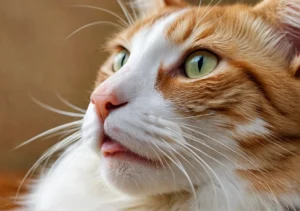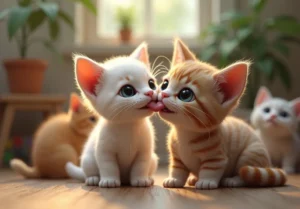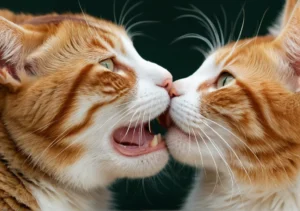Cats can exhibit some unusual behaviors at times, and one behavior that can be cause for concern is when they act like they’re choking. Seeing your feline friend gagging or retching can be distressing, but understanding why they may be doing this is crucial for their health and well-being.
If your cat keeps acting like he’s choking, it may be due to a hairball or a foreign object stuck in their throat. Cats groom themselves by licking their fur, which can lead to the ingestion of loose hairs. These hairs can accumulate in their stomach and form a hairball, causing irritation and the sensation of choking. Additionally, cats are curious creatures that may play with small objects or ingest items they shouldn’t, which can also become lodged in their throat.
Identifying the Signs of Choking in Cats
If you’ve ever seen your cat acting like he’s choking, it can be a frightening experience. Some common signs to look out for include gagging, retching, coughing, and difficulty breathing. Your furry friend might also paw at his mouth or show signs of distress like drooling or panic.
It’s crucial to act quickly if you suspect your cat is choking. A choking cat may have his airway partially or completely blocked, so immediate intervention is necessary to prevent further complications.
How to Help a Choking Cat
If you find yourself faced with a cat in distress, here are some steps you can take to assist:
- Stay calm – Your cat can pick up on your emotions, so it’s important to remain calm to avoid escalating the situation.
- Check the mouth – Carefully open your cat’s mouth and look for any obvious obstructions. Be cautious not to get bitten in the process.
- Perform a modified Heimlich maneuver – If you spot a foreign object obstructing your cat’s airway, you can try a gentle chest compression to dislodge it.
- Seek immediate veterinary care – If your efforts are unsuccessful or your cat’s condition worsens, don’t hesitate to contact your veterinarian for assistance.
Remember, prevention is key when it comes to choking incidents in cats. Keep small objects out of reach, supervise playtime with toys, and avoid feeding your cat bones or other potential choking hazards.
For more information on cat first aid, you can visit the American Red Cross website, which offers valuable resources on pet safety and emergency care. Stay informed and prepared to handle unexpected situations with your beloved feline friend.
Preventative Measures for Choking Incidents
If your cat keeps acting like he’s choking, there are steps you can take to reduce the risk of such incidents. Regular grooming is key in preventing hairballs, which can lead to choking. Brushing your cat regularly can help minimize the amount of hair they ingest while grooming themselves.
Another way to prevent choking is by keeping small objects out of your cat’s reach. Cats are curious creatures and may accidentally swallow items that could block their airway. Be mindful of small toys, strings, or even household items that could pose a choking hazard.
Providing appropriate toys and treats can also help prevent choking episodes. Opt for toys that are too large to be swallowed or easily broken into small pieces. When giving your cat treats, choose soft or moist options that are easy to chew and swallow.
Remember, prevention is key when it comes to keeping your cat safe from choking incidents. By implementing these measures, you can help minimize the risk and keep your feline friend happy and healthy.
The Role of Hairballs in Choking Behavior
Ever wondered why your cat seems to be choking more often than usual? It could be due to hairballs. Hairballs form when your cat ingests loose hair while grooming themselves. These hairballs can obstruct the airway, leading to choking episodes.
To prevent hairballs from causing choking behavior, consider incorporating hairball control products into your cat’s diet. These products can help facilitate the passage of hair through the digestive system, reducing the likelihood of hairball formation.
If your cat is experiencing frequent choking episodes, it’s essential to consult with your veterinarian. They can provide guidance on managing hairballs and recommend any necessary medical treatment. Don’t hesitate to seek professional help if you’re concerned about your cat’s choking behavior.
Remember, understanding the role of hairballs in choking incidents can help you address the issue effectively and keep your cat healthy and happy.
When to Consult a Veterinarian
If your cat is showing signs of choking frequently, it’s essential to know when to seek professional help. While coughing, wheezing, and gagging can sometimes be normal, persistent choking behavior may be a cause for concern. Persistent choking episodes can indicate underlying health issues such as respiratory infections, foreign objects stuck in the throat, or even more serious conditions like cancer. If your cat’s choking episodes are accompanied by symptoms such as difficulty breathing, lethargy, excessive drooling, or refusal to eat, it’s crucial to consult a veterinarian immediately.
Another red flag to watch out for is if your cat’s choking behavior is getting worse over time or if you notice any unusual changes in their overall health. Prompt veterinary intervention can help identify the root cause of your cat’s choking and determine the best course of action to ensure their well-being. Remember, your furry friend’s health is a top priority, so never hesitate to seek professional help when needed.
Helpful Resource : For more information on common cat health issues and when to consult a veterinarian, check out this comprehensive guide from the American Veterinary Medical Association: AVMA Cat Health Resource.
Common Treatments for Choking in Cats
When it comes to treating choking in cats, there are various approaches that vets may recommend based on the underlying cause of your cat’s symptoms. Medication can be prescribed to help reduce inflammation, clear airways, or treat infections that may be contributing to the choking episodes. In some cases, surgical intervention may be necessary to remove obstructions or address structural issues in the throat.
Dietary changes can also play a crucial role in managing your cat’s choking episodes. Switching to softer foods or moistening dry food with water can help make swallowing easier for your cat, reducing the risk of choking. Additionally, avoid feeding your cat bones or small objects that could potentially become lodged in their throat, leading to choking incidents.
Regular veterinary check-ups are essential to monitor your cat’s overall health and address any potential concerns that may be contributing to their choking behavior. By working closely with your veterinarian, you can develop a comprehensive treatment plan tailored to your cat’s specific needs to help them lead a happy and healthy life.
Remember, every cat is unique, so it’s essential to consult with your vet to determine the most appropriate treatment options for your furry friend’s choking issues.
Understanding Potential Underlying Health Issues
Is your feline friend exhibiting behavior that looks like choking? It could be a sign of underlying health issues. Respiratory infections, oral problems, or gastrointestinal issues might be causing your cat to struggle. If you notice this behavior persisting, it’s essential to consult with your veterinarian to rule out any serious health concerns. Remember, your cat’s well-being is a top priority, so don’t hesitate to seek professional advice if needed.
Interesting Fact: Cats’ Protective Mechanisms
Did you know that cats have evolved with specialized tongues and esophageal structures to prevent choking? These protective mechanisms help them navigate their meals efficiently. Despite their occasional coughing or gagging behavior, cats are equipped to handle most situations that might seem alarming to us. If you observe your cat acting like he’s choking, try not to worry too much – the chances are he’s just utilizing these built-in defenses to deal with a minor inconvenience.
Common Causes of Choking Behavior in Cats: 1. Respiratory Infections: Upper respiratory infections can lead to coughing and choking. 2. Dental Issues: Tooth problems or gum disease may cause discomfort while eating. 3. Gastrointestinal Problems: Digestive issues can result in gagging or retching behavior.
Remember, observing your cat’s behavior closely and seeking professional guidance when necessary can help ensure your furry companion stays healthy and happy.
For additional information on feline health and choking behavior, you can check out this helpful resource from the American Society for the Prevention of Cruelty to Animals (ASPCA): ASPCA Cat Care.
Alex, a passionate animal lover, has experience in training and understanding animal behavior. As a proud pet parent to two dogs and three cats, he founded AnimalReport.net to share insights from animal experts and expand his knowledge of the animal kingdom.




